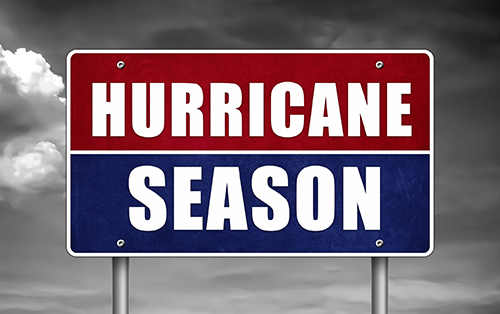
Every minute counts when a hurricane warning is issued, especially when you want to maintain safety and operations at your facility or job site. It’s important to have access to high-demand materials before, during and after a storm. If you prepare for a hurricane with this in mind, you’ll be more likely to minimize damage and lost productivity.
First, let’s brush up on the danger of hurricanes.
How hurricanes form
Hurricanes are one of the most violent storms on Earth. Usually occurring close to the equator over warm ocean waters, they consist of condensed water vapor that morphs into large clouds. The evaporation and condensation continue to build, with the cloud columns increasing in size.
Eventually, a pattern begins to develop in the form of winds circulating around a center point. As moving air encounters more clouds, it transforms into a cluster of thunderstorm clouds, referred to as a tropical disturbance. Condensed air continues to circulate and wind speeds pick up around the eye of the storm. Once wind speeds reach 74 mph, the tropical storm has officially become a hurricane.
The 5 categories to be aware of
The Atlantic hurricane season runes June 1 through November 30 each year, bringing the risk of heavy rain and winds that can cause significant property damage, road blocks and power outages. Here are the five categories of a hurricane:
- Category 1: 74-95 (minor damage)
- Category 2: 96-110 mph (uprooted trees)
- Category 3: 111-129 mph (broken windows and doors)
- Category 4: 130-156 mph (missing roofs)
- Category 5: 157+ mph (catastrophic damage that can level buildings)
Organizations like the National Hurricane Center, Red Cross and Centers for Disease Control and Prevention (CDC) have created guidelines about what to do if a storm is expected. Here are some suggestions they lay out for individuals:
- Plan an evacuation route.
- Establish a rendezvous point in case of separation.
- Pack nonperishable food and clean water.
- Have an emergency kit.
- Charge your devices to maintain communication and stay up to date on the storm.
- Find out where local evacuation shelters are located.
- Don’t attempt to drive through floodwater.
- Bring proper clothing and take steps to insulate your clothes.
Prepare for a hurricane with the right materials at your location
When a hurricane warning is issued, it’s time to take action. Keep your facility and employees safe and gain peace of mind by using this material checklist to ensure you have what you need:
- Air compressors
- Alkaline batteries
- Barrier tape
- Boots
- Brooms
- Canvas and polyethylene tarps
- Carpet dryers/blowers
- Chain saws
- Coolers
- Drain hoses
- Drills
- Duct tape
- Engine oil
- Extension cords and adapters
- Fasteners
- First aid kits
- Flashlights
- Floor squeegees
- Generators
- Glow-sticks
- Hammers
- Lanterns
- Leather palm gloves
- Masking tape
- Masonry screws
- Mops and buckets
- Motors
- Nylon rope
- Paper cups
- Polyethylene gas cans
- Pumps
- Radios
- Rain suits
- Safety vests
- Shovels
- Sorbents
- Vehicle recovery straps
- Water coolers
- Wet/dry vacuums
Recovering from the storm
Recovering from a hurricane is a gradual process and safety is a primary issue. Hurricanes prompt many questions about water-damaged electric equipment. Can the equipment be dried out? Is the circuit breaker still okay to use? Can the switchboard be re-energized?
Keep in mind that, in many cases, the water that has been in contact with the equipment has been contaminated with sewage, chemicals or other substances that can negatively affect the electrical equipment’s integrity. Consider the following information when assessing wet electrical equipment:
- Electrical equipment that has been submerged must be replaced. (There are exceptions to this rule for larger equipment.)
- Some surfaces might be in areas that can’t easily be dried out or cleaned of debris.
- Residual debris or wet surfaces may result in a loss of dielectric spacing within the equipment, and could present a hazard upon re-energization.
- Molded case circuit breakers should never be re-energized if they have been in contact with water.
Being ready for a hurricane can help you stay safe, maintain daily operations, minimize property damage and reduce stress, but you need to act before the threat becomes imminent. Make sure you work with supply chain professionals to get the right materials for a hurricane before it’s too late.
Related posts
Job site winter storm preparation | Severe weather emergency action plan
How to use a defibrillator: ZOLL AED Plus features voice instructions